What's eating my arum lilies?
Summer is settling in, we've had good rain, plants are recovering, birds are singing, butterflies are flitting – did I say 'butterflies'?
Butterflies and moths, as innocent as they appear, have a definite sting in the tail. To enjoy their intricate colours, their delicate dips and swings across the sun-kissed garden and their evening hovering among scented blooms, we have to live with their myriad offspring which chomp, chew and generally deface our carefully tended plants, shrubs and trees.
The Culprit
One of the most voracious of these is the caterpillar of the Hawk Moth, which can strip a plant of all its leaves in a matter of days. The Arum lily is one of the host plants for Hippotion celerio, commonly known as the Silver-striped Hawk Moth or Grape Vine Hawk Moth. This is an exceptionally handsome, neat looking moth with a wingspan of 76 mm and longitudinal pale brown and olive-brown stripes along the body and wings. The Arum lily is one of the host plants for this moth. I followed one caterpillar's development from the beginning of June until the middle of July 2011 during which time it ate its way through three bags of young arum lilies before it was ready to pupate.
A week or so later the teeny, cute little green caterpillar was a staunch 7 or 8 centimetres long, had turned brown and descended to the base of the plant where once again it blended perfectly with its surroundings. Here it spent the day in hiding, creeping up during the night to continue its depredations.
Once it had eaten its fill, fattened and slightly swollen, it descended to the ground and lay sluggishly on the debris for a day or two, no longer ascending for its nightly feed. It then made a rudimentary shelter in a hollow between the stalks with a few strands of silk at the base of the plant to await metamorphosis.
A couple of weeks later I carefully removed it from its nest to take these photos, then replaced it to continue its journey. Unfortunately I waited too long to witness its emergence and by the time I went to check on it, it had already flown away.
I hope in the future to photograph one of the moths of this species to add to the blog so as to complete the cycle. In the meantime you can go here https://www.google.co.za/search?q=hippotion+celerio+moth&es_sm=93&tbm=isch&tbo=u&source=univ&sa=X&ei=toNbU9aTGIey7AbtsIGgDA&ved=0CDkQsAQ&biw=1160&bih=563 to see pictures of the adult moth.
The impact on my Arums
The damage to the arum lilies was the loss of their leaves which admittedly hindered their growth but they recover. To save your Arums, visit them regularly and check for eaten leaves and along the stems, where you will find the culprits.
I have also included a (rather poor) picture of two eaten leaves so you have a better idea of what to look for when searching your plants to find the caterpillars. Notice that the eaten edges of the leaf on the left are brownish and dried. This is old damage and the caterpillar has probably moved on. The edges of the leaf on the right are still green. This is where the culprit has been eating during the previous night. Look under leaves with fresh, green edges like this and you will most likely find the caterpillar.
Before you go on the rampage, consider the results of your actions
So now it's up to you. You may decide to pick off and destroy both the eggs and the caterpillars, but bear the results of this action in mind: birds will find less food in your garden and may leave to find food elsewhere, night blooming flowers will not be pollinated and bats will be deprived of a protein packed 'snack on the wing'.
It's all about balance. Three seasons back, in my innocence and to my shame, I eradicated every hawk moth egg and caterpillar I came across, so decimating the population of this species of Hawk Moth in my garden that I found no caterpillars last season and only five this season, of which three disappeared before reaching maturity - presumably eaten by birds. This season I sacrificed a few of my arum lilies to protect next season's generation of hawk moths and I have learnt to live and let live. It's scary how long it takes for a species to renew itself after the damage is done!



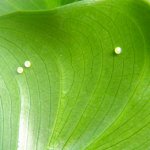
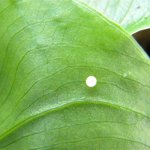
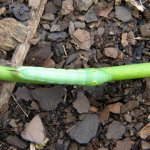

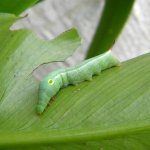


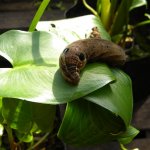

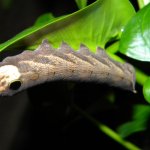
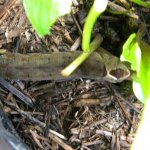
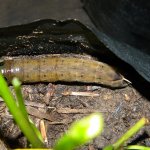
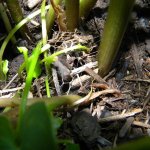
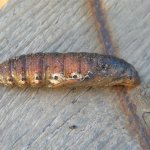
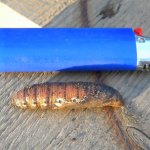
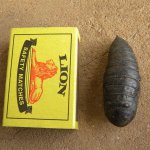

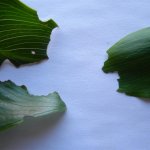


Comments
Caterpillars
Your blog and pictures are so explanatory. I have seldom seen hawk months, but find them wonderful as well as the very large green caterpillar which I imagine to be a hawk month's. I write now to say that if one sees the whole metomophosis from egg to caterpillar to crysillis to moth is quite important. I kept some of the amaryllis caterpillars in a box with crinum leaves as food (I have many mooreii) until they became crysillus and then moth and eggs. Now I know what they all look like and can take action. I dont believe that these caterpillars are eaten by birds as they are yellow and black and as such tell birds etc they are poisonous. I found some cryssilus under the crinums today and could kill them.
Amaryllis caterpillars
Amaryllis caterpillars or Brithys crini pancratii are a scourge. I agree with you that birds and other vertebrates do not eat them - according to Wikipedia they are in fact poisonous. This pest is also known as the Lily borer and attacks crinums, clivia, scadoxus and haemanthus. I have had huge infestations of them and have been forced to use Blue Death. I have not really studied them and would like to know what the moth looks like. Could you perhaps describe it?
Amaryllis Caterpillars
There is an organic insecticide available that is very target specific. It is marketed by Margaret Roberts and the active ingredient is Bacillus Thuringiensis. It works wonderfully well.
Amaryllis caterpillars
Hi Tracy
Many thanks for your input. I'll definitely give this a try and I'm sure I won't be the only one.
Amaryllis caterpillars
I replied as above and dont really have much to add. The moth of the Amaryllis caterpillar only likes the amarylidacea family not arums on which to lay its eggs and is a reasonably large one, very dark wings that fold back rather than spread sideways. I found a couple in my lounge the other night and they got squashed. The green caterpillars may be hawk moth caterpillars. I have seen some that are not so green, but may have been older. I wish I knew what nibbles the edges of yellow Arums. The hybrid coloured arums and white are not so attractive to whatever it is. My Crinum moorei are just starting to bud so they got a dose of Karbaspray. Sometimes I just powder all the plants and then water, but now I sprayed the flowers very specifically. I have a lot of crinums - 4 varieties.
Amaryllis caterpillars
As much as I like the hawk moth, I loathe the caterpillars! I may be acting really un-PC and ungreen, but I kill the buggers. Birds do not eat them. In two days I killed six which between them virtually destoyed my arums. Well, there are just about no leaves left on my plants.I am also not very keen on them attacking my clivias. Maybe I should resort to blue death as well, although I never use poisons of whatever nature in my garden.
Arum lily devastation
Hi Dudley I avoid using poisons in the garden at all but the pots in the nursery are terribly vulnerable and when an entire generation of 5 year old crinum bulbs is at risk of being annihilated, there's not much else to do. I have not had the hawk moth larvae attack my clivias yet - the amaryllis caterpillars enjoy them though. Perhaps give the arums a dressing of compost and water them regularly. They'll soon have a new lease on life.
CATERPILLARS
I must be lucky in only seeing one Hawkmoth caterpillar in my garden. I thought it very beautiful; did not kill it, just took a couple of pictures. What I did to was to collect about 10 of the amaryllis caterpillars and grow them on to see what the crysillus looks like and then the moth. During the time it took - about 2 weeks - for the stages to take place I found that the caterpillrs preferred the leaves of Crinum moorei to the crinum. In the new bulb book by Graham Duncan it is also stated that crinum leaves are their preference. It is not surprising that the crysillis is never seen - blends in with the soil. The moth tho is more obvious in that it is fairly large and nearly black. During the past few weeks I have killed off quite a few of these monsters. The amaryllis caterpillar likes all the amaryllis family which include nerines and cyrthanthus so if you are like me and like bulbs then it is best to control these horrors. I have managed to have quite a number of Crinum moorei flowering at the moment having sprayed the buds as they emerge. Not much in the way of leaves now as they die off and then reappear later. My Nerine masoniorum are just starting to flower so need attention.
Brown hairy caterpillars
I have a mostly indigenous garden and so have little problems with bugs
I have a Horsewood that happily gets eaten to nothing by some stunningly bright green caterpillars and then bounces back better than ever when they hatch into large black and yellow butterflies
The Kiggaleria also has a specific tiny black, spiky guy who does no harm and is relished by the birds
BUT
Last winter we were infested by small hairy caterpillars
they ate the Chrysanthamoides to nothing, which is usually very hardy, it bounced back
Sadly they killed my lovely lilac Selago
I have lots of birds but I didn't see any of them eating these little pests
What should I do if they come back next winter
I hate to spray!
But if I must then which spray is safest for the other friendly critters, lizards, birds, etc
Thank you for always being so amazingly helpful and informative Loraine :D
Organic caterpillar poison
Hi Liza
There are times when a particular bug becomes really harmful. MARGARET ROBERTS (Dipel DF)BIOLOGICAL CATERPILLAR INSECTICIDE is your best bet. You can read about it (and a number of other organic insecticides) here: http://www.gardencare.co.za/profile_insecticide.htm
The active ingredient is Dipel, so any insecticide with this as the main ingredient should be fine.
Kind regards
Lorraine
What a very informative and
What a very informative and well written piece. I have been searching the net for an hour and was about to give up as to what this caterpillar was when I stumbled across your article. We have a few hawk moth caterpillars in our garden and they are eating my pentas. I have lillies so I will encourage them to eat those instead as the pentas is all eaten up...They really are big eaters. Thanks once again. Clare
Hi Clare
Hi Clare
Thank you for your comment.
And yes, they really do eat an enormous amount!
Kind regards
Lorraine
Add new comment